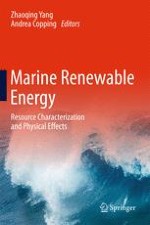2017 | OriginalPaper | Chapter
Ocean Current Energy Resource Assessment for the Gulf Stream System: The Florida Current
Authors : Kevin Haas, Xiufeng Yang, Vincent Neary, Budi Gunawan
Published in: Marine Renewable Energy
Publisher: Springer International Publishing
Activate our intelligent search to find suitable subject content or patents.
Select sections of text to find matching patents with Artificial Intelligence. powered by
Select sections of text to find additional relevant content using AI-assisted search. powered by
